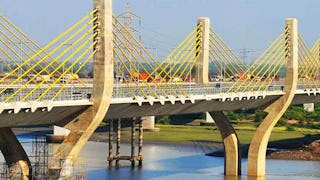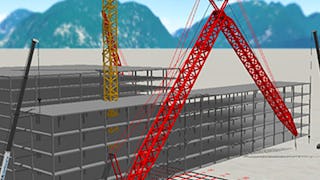This bridge engineering course equips you to transform bridge concepts into reality. It explores bridge types and their suitability for various applications. You'll delve into bridge history, appreciating how past designs influence modern practices. The course emphasizes the roles of bridge components: the superstructure and the substructure in ensuring stability and functionality.


Conceptual Planning of Bridges
This course is part of Bridge Infrastructure Design Specialization

Instructor: Subject Matter Expert
Included with
(10 reviews)
Recommended experience
Skills you'll gain
Details to know

Add to your LinkedIn profile
4 assignments
See how employees at top companies are mastering in-demand skills

Build your subject-matter expertise
- Learn new concepts from industry experts
- Gain a foundational understanding of a subject or tool
- Develop job-relevant skills with hands-on projects
- Earn a shareable career certificate

There are 4 modules in this course
Delve into the world of bridge engineering in this introductory module! We'll explore the history of bridges, how they're classified by material, form, use, and more. We'll break down the key components that make up a bridge, from its main structure to its safety features. By the end, you'll have the ability to identify the different components and types of bridges.
What's included
12 videos1 assignment
We'll delve into the intricate process of bringing a bridge from concept to reality. We'll explore the planning stages, analyzing factors like site characteristics, traffic flow, and environmental impact. Detailed investigations into soil conditions, water currents, and wind conditions ensure a safe and durable structure. Then, we'll dive into the design phase, considering bridge type, functionality, and even aesthetics. Finally, we'll cover the meticulous execution process, from construction planning to testing and commissioning. By the end of this module, you'll be able to explain the journey a bridge takes in the stage of planning.
What's included
9 videos1 assignment
Dive into the world of bridge design by understanding the forces they have to withstand! The module explores various types of loads, from permanent loads to dynamic loads. We'll analyze how these loads are combined for design purposes, following IRC guidelines. You'll learn about specific loads for highway, railway, and pedestrian bridges, including construction phase considerations. Thermal effects, water current forces, and accidental impacts are factored in. By the end, you'll be equipped to design bridges that can handle the full spectrum of forces they'll encounter throughout their lifespan.
What's included
17 videos1 assignment
We'll delve into the calculations that ensure a bridge's strength. We'll explore various analysis methods, from traditional hand calculations like Pigeaud's method for slabs to advanced computer-aided tools like Finite Element Analysis (FEM). You'll learn about grillage analysis, which breaks down a bridge deck into a network of beams to understand load distribution. We'll also tackle examples using grillage analysis for different bridge configurations like slab bridges and slab & beam bridges. By the end, you'll possess a strong foundation for analyzing and designing bridges that can withstand various stresses and strains.
What's included
8 videos1 assignment
Earn a career certificate
Add this credential to your LinkedIn profile, resume, or CV. Share it on social media and in your performance review.
Instructor

Offered by
Explore more from Environmental Science and Sustainability
 Status: Free Trial
Status: Free TrialL&T EduTech
 Status: Free Trial
Status: Free TrialL&T EduTech
 Status: Free Trial
Status: Free Trial Status: Free Trial
Status: Free TrialL&T EduTech
Why people choose Coursera for their career





Open new doors with Coursera Plus
Unlimited access to 10,000+ world-class courses, hands-on projects, and job-ready certificate programs - all included in your subscription
Advance your career with an online degree
Earn a degree from world-class universities - 100% online
Join over 3,400 global companies that choose Coursera for Business
Upskill your employees to excel in the digital economy
Frequently asked questions
To access the course materials, assignments and to earn a Certificate, you will need to purchase the Certificate experience when you enroll in a course. You can try a Free Trial instead, or apply for Financial Aid. The course may offer 'Full Course, No Certificate' instead. This option lets you see all course materials, submit required assessments, and get a final grade. This also means that you will not be able to purchase a Certificate experience.
When you enroll in the course, you get access to all of the courses in the Specialization, and you earn a certificate when you complete the work. Your electronic Certificate will be added to your Accomplishments page - from there, you can print your Certificate or add it to your LinkedIn profile.
Yes. In select learning programs, you can apply for financial aid or a scholarship if you can’t afford the enrollment fee. If fin aid or scholarship is available for your learning program selection, you’ll find a link to apply on the description page.
More questions
Financial aid available,

